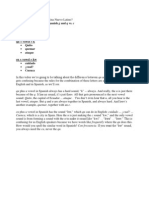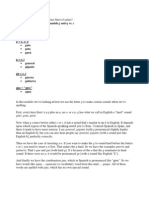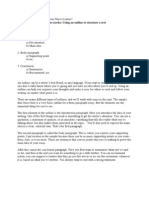Enchufes PDF 5E-11 Muletillas
Uploaded by
Gillian Lord-WardEnchufes PDF 5E-11 Muletillas
Uploaded by
Gillian Lord-WardEnchufes 5E: Cocina para torpes Enchufe al habla
Fillers and discourse markers
muletillas
ah a ver as pues bueno digo eh emm es decir este esto es luego no? no crees? o sea pues vale
A discourse marker is a word or phrase that we use when were speaking and that doesnt have any meaning. It doesnt change what the sentence youre saying means, it just helps you either continue the flow of the sentence or pause for time. Some examples of discourse markers in English are oh, well, um. And within the class of discourse markers we also have something called fillers. In Spanish these are called muletillas, which means little crutches, and thats exactly what they are: theyre crutches to help you speak. For example, we have the list above. All these words can mean something, and you can see on the list you have in your text what their literal translation is. But when you use them in a sentence as fillers, they dont actually convey any meaning. Theyre pretty much devoid of any kind of content. In Spanish you say ah..., a ver..., pues..., esto... when youre trying to think what to say next or when you need to pause for time. We do this in English too: in English we say things like you know..., like..., um... Its the same idea. In English we do this without thinking; its one of our natural oral speech tendencies. But in Spanish, because its not our natural first language, we have to learn the filler words. But these are really good for you to use as youre speaking. They will make you sound more natural, but they will also help you pause for time that you need to think. Youll notice that each speaker has one or two fillers that are their favorites. I for example use pues and o sea a lot; other speakers will say luego more often. It just depends on their personal preference and which they feel more comfortable using. You should practice using these and using them to fill in the little spaces in your speech. This will keep you from having to switch back into English, so if you dont know a word and need to think about it, instead of saying oh! ... wait! ... hold on! you can say emm ... este... as youre thinking. This will help you sound a lot more fluent when youre speaking in Spanish.
You might also like
- The Everything Essential Brazilian Portuguese Book: All You Need to Learn Brazilian Portuguese in No Time!From EverandThe Everything Essential Brazilian Portuguese Book: All You Need to Learn Brazilian Portuguese in No Time!5/5 (1)
- Spanish for Gay Men (Spanish That Was Never Taught in the Classroom!)From EverandSpanish for Gay Men (Spanish That Was Never Taught in the Classroom!)No ratings yet
- Essential Indonesian Phrasebook & Dictionary: Speak Indonesian with Confidence! (Revised and Expanded)From EverandEssential Indonesian Phrasebook & Dictionary: Speak Indonesian with Confidence! (Revised and Expanded)5/5 (1)
- Learn Intermediate Spanish In 30 Days: The Beginners Language Learning Accelerator- Short Stories, Common Phrases, Grammar, Conversations, Essential Travel Terms& Words In ContextFrom EverandLearn Intermediate Spanish In 30 Days: The Beginners Language Learning Accelerator- Short Stories, Common Phrases, Grammar, Conversations, Essential Travel Terms& Words In ContextNo ratings yet
- Accent Reduction For Professionals: How to Eliminate Your Accent to Sound More AmericanFrom EverandAccent Reduction For Professionals: How to Eliminate Your Accent to Sound More American4.5/5 (15)
- Daily Spanish For Beginners: How To Easily Speak Spanish With Only 12 Minutes Of Practice A DayFrom EverandDaily Spanish For Beginners: How To Easily Speak Spanish With Only 12 Minutes Of Practice A DayNo ratings yet
- Spanish for Geniuses: Verbs, Pronouns, Prepositions and Beginner VocabularyFrom EverandSpanish for Geniuses: Verbs, Pronouns, Prepositions and Beginner Vocabulary5/5 (5)
- Conversational Spanish for Beginners and Travel Dialogues Volume IV: Learn Spanish Phrases And Important Latin American Spanish Vocabulary Quickly And Easily In Your Car Lesson By LessonFrom EverandConversational Spanish for Beginners and Travel Dialogues Volume IV: Learn Spanish Phrases And Important Latin American Spanish Vocabulary Quickly And Easily In Your Car Lesson By LessonNo ratings yet
- Tongue Twisters, Rhymes, and Songs to Improve Your English PronunciationFrom EverandTongue Twisters, Rhymes, and Songs to Improve Your English Pronunciation5/5 (1)
- Must-Know Spanish Travel Phrases For a Fun Trip: Learn How to Be Polite, Book a Table at the Restaurant, Ask for Directions, and much more in any Spanish-Speaking Country (English to Spanish)From EverandMust-Know Spanish Travel Phrases For a Fun Trip: Learn How to Be Polite, Book a Table at the Restaurant, Ask for Directions, and much more in any Spanish-Speaking Country (English to Spanish)No ratings yet
- Spanish Verb Conjugation and Tenses Practice Volume V: Learn Spanish Verb Conjugation with Step by Step Spanish Examples Quick and Easy in Your Car Lesson by LessonFrom EverandSpanish Verb Conjugation and Tenses Practice Volume V: Learn Spanish Verb Conjugation with Step by Step Spanish Examples Quick and Easy in Your Car Lesson by LessonNo ratings yet
- Learn Spanish: A beginner's guide to learning basic Spanish fast, including useful common words and phrases!From EverandLearn Spanish: A beginner's guide to learning basic Spanish fast, including useful common words and phrases!No ratings yet
- The Spanish Verbs & Phrases Workbook For Adult Beginners: Spanish Language LearningFrom EverandThe Spanish Verbs & Phrases Workbook For Adult Beginners: Spanish Language LearningNo ratings yet
- Learn Spanish Blueprint For Beginners (2 in 1): Reach Intermediate Levels Fast With 50+ Complete Language Lessons- 1000+ Phrases& Words, Grammar, Short Stories& ConversationsFrom EverandLearn Spanish Blueprint For Beginners (2 in 1): Reach Intermediate Levels Fast With 50+ Complete Language Lessons- 1000+ Phrases& Words, Grammar, Short Stories& ConversationsNo ratings yet
- Madrigal's Magic Key to Spanish: A Creative and Proven ApproachFrom EverandMadrigal's Magic Key to Spanish: A Creative and Proven Approach2/5 (1)
- Conversational Spanish for Beginners and Travelers Volume II: Learn Spanish Phrases and Important Latin American Spanish Vocabulary Quickly and Easily in Your Car Lesson by LessonFrom EverandConversational Spanish for Beginners and Travelers Volume II: Learn Spanish Phrases and Important Latin American Spanish Vocabulary Quickly and Easily in Your Car Lesson by LessonNo ratings yet
- Easy Spanish Phrase Book NEW EDITION: Over 700 Phrases for Everyday UseFrom EverandEasy Spanish Phrase Book NEW EDITION: Over 700 Phrases for Everyday Use3/5 (5)
- Spanish Verb Conjugation and Tenses Practice Volume II: Learn Spanish Verb Conjugation with Step by Step Spanish Examples Quick and Easy in Your Car Lesson by LessonFrom EverandSpanish Verb Conjugation and Tenses Practice Volume II: Learn Spanish Verb Conjugation with Step by Step Spanish Examples Quick and Easy in Your Car Lesson by Lesson5/5 (1)
- English Everyday: Higher-Level Ability and Understanding. Level 1. the VerbsFrom EverandEnglish Everyday: Higher-Level Ability and Understanding. Level 1. the Verbs5/5 (1)
- What They Didn't Teach You in Spanish Class: Slang Phrases for the Café, Club, Bar, Bedroom, Ball Game and MoreFrom EverandWhat They Didn't Teach You in Spanish Class: Slang Phrases for the Café, Club, Bar, Bedroom, Ball Game and More4/5 (1)
- Essential Cantonese Phrasebook & Dictionary: Speak Cantonese with Confidence (Cantonese Chinese Phrasebook & Dictionary with Manga illustrations)From EverandEssential Cantonese Phrasebook & Dictionary: Speak Cantonese with Confidence (Cantonese Chinese Phrasebook & Dictionary with Manga illustrations)No ratings yet
- Learn Italian: A beginner's guide to learning basic Italian fast, including useful common words and phrases!From EverandLearn Italian: A beginner's guide to learning basic Italian fast, including useful common words and phrases!No ratings yet
- Conversational Spanish for Beginners and Travel Dialogues Volume III: Learn Spanish Phrases and Important Latin American Spanish Vocabulary Quick and Easy in Your Car Lesson by LessonFrom EverandConversational Spanish for Beginners and Travel Dialogues Volume III: Learn Spanish Phrases and Important Latin American Spanish Vocabulary Quick and Easy in Your Car Lesson by LessonNo ratings yet
- Latin American Spanish for Beginner and Intermediate, Flash Two In OneFrom EverandLatin American Spanish for Beginner and Intermediate, Flash Two In One4/5 (1)
- 1600+ Essential Portuguese Phrases: Easy to Intermediate - Pocket Size Phrase Book for TravelFrom Everand1600+ Essential Portuguese Phrases: Easy to Intermediate - Pocket Size Phrase Book for Travel5/5 (1)
- Learn Spanish for Beginners: Easy Step-by-Step Method to Start Learning Spanish TodayFrom EverandLearn Spanish for Beginners: Easy Step-by-Step Method to Start Learning Spanish Today4.5/5 (2)
- Learn Spanish Grammar: How to Understand and Speak at Home, on the Road, or Traveling in the Car, Even If You’re a Beginner. Common Phrases, Instruction, and Pronunciation for ConversationsFrom EverandLearn Spanish Grammar: How to Understand and Speak at Home, on the Road, or Traveling in the Car, Even If You’re a Beginner. Common Phrases, Instruction, and Pronunciation for Conversations5/5 (3)
- Spanish: Learn Spanish for Beginners In A Fun and Easy Way: Including Pronunciation, Spanish Grammar, Reading, and Writing, Plus Short Stories By: University of LinguisticsFrom EverandSpanish: Learn Spanish for Beginners In A Fun and Easy Way: Including Pronunciation, Spanish Grammar, Reading, and Writing, Plus Short Stories By: University of LinguisticsNo ratings yet
- Easy Tagalog Phrase Book: Over 1500 Common Phrases For Everyday Use And TravelFrom EverandEasy Tagalog Phrase Book: Over 1500 Common Phrases For Everyday Use And TravelNo ratings yet
- Italian For Beginners: A Practical Guide to Learn the Basics of Italian in 10 Days!From EverandItalian For Beginners: A Practical Guide to Learn the Basics of Italian in 10 Days!4/5 (1)
- Italian for Beginners: The COMPLETE Crash Course to Speaking Basic Italian in 5 DAYS OR LESS! (Learn to Speak Italian, How to Speak Italian, How to Learn Italian, Learning Italian, Speaking Italian)From EverandItalian for Beginners: The COMPLETE Crash Course to Speaking Basic Italian in 5 DAYS OR LESS! (Learn to Speak Italian, How to Speak Italian, How to Learn Italian, Learning Italian, Speaking Italian)No ratings yet
- SPANISH - Learn 35 VERBS to speak Better Spanish: With only 5% of the usual time and effort!From EverandSPANISH - Learn 35 VERBS to speak Better Spanish: With only 5% of the usual time and effort!No ratings yet
- Spanish : Learn the way to become bilingual in Spanish: The self help guide to learn Spanish in a week. 10 X YOUR SPANISHFrom EverandSpanish : Learn the way to become bilingual in Spanish: The self help guide to learn Spanish in a week. 10 X YOUR SPANISHNo ratings yet
- Write Research Right!: The EFL Writer's Step-by-Step Guide to a Publishable Research PaperFrom EverandWrite Research Right!: The EFL Writer's Step-by-Step Guide to a Publishable Research Paper1/5 (1)
- Dirty Spanish Workbook: 101 Fun Exercises Filled with Slang, Sex and SwearingFrom EverandDirty Spanish Workbook: 101 Fun Exercises Filled with Slang, Sex and SwearingNo ratings yet
- Portuguese English Frequency Dictionary - Essential Vocabulary - 2.500 Most Used Words: Portuguese, #1From EverandPortuguese English Frequency Dictionary - Essential Vocabulary - 2.500 Most Used Words: Portuguese, #13.5/5 (4)
- Enchufes: Proposal For A Native-Digital Learning Environment For First-Year Spanish CoursesNo ratings yetEnchufes: Proposal For A Native-Digital Learning Environment For First-Year Spanish Courses14 pages
- Qu vs. Cu: Enchufe A La Ortografía: Spanish G and Q vs. CNo ratings yetQu vs. Cu: Enchufe A La Ortografía: Spanish G and Q vs. C1 page
- Letter G: Enchufe A La Ortografía: Spanish G and Q vs. CNo ratings yetLetter G: Enchufe A La Ortografía: Spanish G and Q vs. C1 page
- Estrategia de Comunicación Escrita: Using An Outline To Structure A TextNo ratings yetEstrategia de Comunicación Escrita: Using An Outline To Structure A Text2 pages
- Genre: Estrategia de Comprensión de Lectura: Using Genre/format To Predict ContentNo ratings yetGenre: Estrategia de Comprensión de Lectura: Using Genre/format To Predict Content1 page
- Enchufe Comunicativo 5B-1. ¿Sabes Dibujar? (Pictionary) : Enchufes Module 5B (Sample)No ratings yetEnchufe Comunicativo 5B-1. ¿Sabes Dibujar? (Pictionary) : Enchufes Module 5B (Sample)4 pages
- Drawing Contrasts and Asking Questions: Enchufe EstructuralNo ratings yetDrawing Contrasts and Asking Questions: Enchufe Estructural2 pages






































































